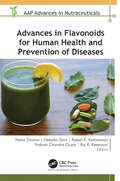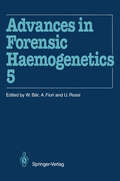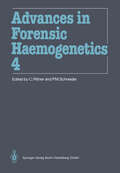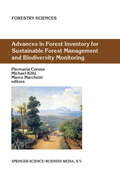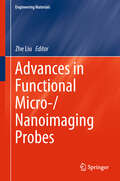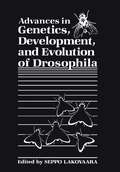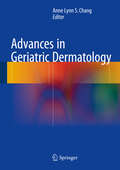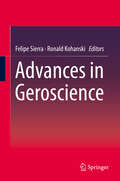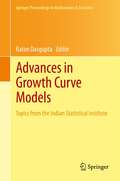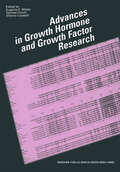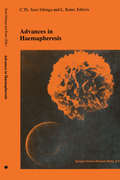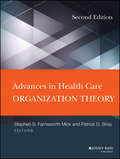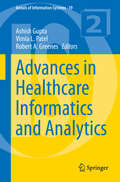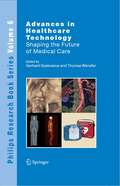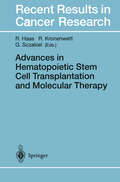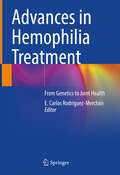- Table View
- List View
Advances in Flavonoids for Human Health and Prevention of Diseases (AAP Advances in Nutraceuticals)
by Nisha Sharma Deepika Saini Rajesh K. Kesharwani Prakash Chandra Gupta Raj K. KeservaniIn response to the recent upsurge of interest in the therapeutic potential of medicinal plants, with their promising phenolic compounds, this new book offers an important overview of advances in the applications of flavonoids for health. The book explores the nutritional and pharmacological properties of polyphenols and flavonoids, including their ability to prevent the start and development of diseases and how they aid in the management of several chronic pathological illnesses, including cancer, diabetes, cardiovascular disease, neuro-degenerative illness and aging, pregnancy-induced disorders, and others. Also discussed in depth are the properties, classes, and degrees that formulate a phenolic compound and which subsequently supports the development of drugs/products with health benefits.
Advances in Forensic Haemogenetics: 15th Congress of the International Society for Forensic Haemogenetics (Internationale Gesellschaft für forensische Hämogenetik e.V.), Venezia, 13–15 October 1993 (Advances in Forensic Haemogenetics #5)
by Walter Bär Angelo Fiori Umberto Rossith This volume comprises the Proceedings of the 15 Congress of the International Society of Forensic Haemogenetics (ISFH), held for the first time in Venezia Lido, th th Italy, on 13 -15 October 1993. The abstracts of the scientific contributions sent to the Congress have been sub divided into chapters with numbers and headings corresponding to the Congress sessions listed in the final programme. A general index of all authors, in alpha betical order, is given at the end of the book. The book consists of 188 contributions and addresses several problems presently being discussed in forensic haemogenetics. The main portion is, of course, devoted to DNA technology: present and future trends in DNA method ology, DNA polymorphisms in paternity testing and in criminal investigation, DNA sequencing, PCR methodology, quality control and quality assurance. Data have been accumulated on population genetics and biostatistics. A new look has been given at old friends, with important contributions on the molecular biology of classical markers. Conventional genetic markers have been studied. Problems connected with genetic typing and human rights have been dealt with in depth, and the history and geography of human genes have been elucidated.
Advances in Forensic Haemogenetics: 13th Congress of the International Society for Forensic Haemogenetics (Internationale Gesellschaft für forensische Hämogenetik e.V.) New Orleans, October 19–21, 1989 (Advances in Forensic Haemogenetics #3)
by H. F. Polesky Wolfgang R. MayrThe third volume of "Advances in Forensic Haemogenetics" contains the th scientific contributions presented at the 13 Congress of the International Society for Forensic Haemogenetics, held on October 19-21, 1989 in New Orleans, USA. The conference was organized and chaired by Dr. Herbert Polesky from Minneapolis. He and the local organizing committee which consisted of our friends and colleagues (J. Soubrada, L.R.Bryant, Dale D.Dykes, Ch.Harrison, P.Newall and R. Walker) deserve the thanks of our Society for a very successful meeting. Herb Polesky has also contributed a great deal to the preparation of this book. The contributions to the conference covered all fields of forensic haemo genetics, but an outstanding highlight of this conference was the application ofDNA-polymorphisms to paternity and to the identification of stains. This included basic lectures on biostatistical approaches as well as on molecular biology and many new technical approaches to our general and special aims. Forensic haemogenetics has now merged into a new discipline without having lost its original identity. On behalf of the Executive Committee of our Society I would like to extend my thanks to the authors of the articles contained in this book and to Springer-Verlag for having made such a quick publication possible. The volume should give the reader a picture of the state of the art and a survey of the most recent developments in the field of forensic and general haemo genetics.
Advances in Forensic Haemogenetics: 12th Congress of the Society for Forensic Haemogenetics (Gesellschaft für forensische Blutgruppenkunde e.V.) Vienna, August 26–29, 1987 (Advances in Forensic Haemogenetics #2)
by Prof. Dr. Wolfgang R. MayrAdvances in Forensic Haemogenetics: 14th Congress of the International Society for Forensic Haemogenetics (Internationale Gesellschaft for forensische Hämogenetik e.V.), Mainz, September 18–21, 1991 (Advances in Forensic Haemogenetics #4)
by Christian Rittner Peter M. SchneiderAdvances in Forest Inventory for Sustainable Forest Management and Biodiversity Monitoring (Forestry Sciences #76)
by Piermaria Corona Michael Köhl Marco MarchettiForests represent a remnant wilderness of high recreational value in the densely populated industrial societies, a threatened natural resource in some regions of the world and a renewable reservoir of essential raw materials for the wood processing industry. In June 1992 the United Nations Conference on the Environment and Development (UNCED) in Rio de Janeiro initiated a world-wide process of negotiation with the aim of ensuring sustainable management, conservation and development of forest resources. Although there seems to be unanimous support for sustainable development from all quarters, there is no generally accepted set of indicators which allows comparisons to be made between a given situation and a desirable one. In a recent summary paper prepared by the FAO Forestry and Planning Division, Ljungman et al. (1999) find that forest resources continue to diminish, while being called upon to produce a greater range of goods and services and that calls for sustainable forest management will simply go unheeded if the legal, policy and administrative environment do not effectively control undesirable practices. Does the concept of sustainable forest management represent not much more than a magic formula for achieving consensus, a vague idea which makes it difficult to match action to rhetoric? The concept of sustainable forest management is likely to remain an imprecise one, but we can contribute to avoiding management practices that are clearly unsustainable.
Advances in Functional and Reparative Neurosurgery (Acta Neurochirurgica Supplement #99)
by Jin Woo Chang Yoichi Katayama Takamitsu YamamotoNeurorehabilitation together with functional neurosurgery are steadily growing fields. In order to encapsulate such concepts, the fourth official scientific meeting of the Neurorehabilitation and Reconstructive Neurosurgery Committee of the World Federation of Neurosurgical Societies (WFNS) was held in Seoul. This volume is the fourth in a new series of proceedings covering the most important advancements in this field.
Advances in Functional Micro-/Nanoimaging Probes (Engineering Materials)
by Zhe LiuThis book highlights the latest advances in functional micro/nano imaging probes and their applications for biomedical imaging and therapy. Given the rapid emergence of transdisciplinary research and applications in materials, chemical probes and translational medicine in recent years, scientists in these areas are expected to keep up to date on the latest technologies and advances to promote comprehensive innovations. Addressing this need, the book presents recently introduced features, emerging techniques, and new strategies, complemented by detailed illustrations. Covering the status quo and offering an outlook on the future, it benefits all readers with an interest in functional materials, especially micro/nano imaging materials for biomedical imaging applications, providing them with both vital updates and inspiration for their own research.
Advances in Fungal Biotechnology for Industry, Agriculture, and Medicine
by Jan S. Tkacz Lene LangeIn the past half century, filamentous fungi have grown in commercial importance not only in the food industry but also as sources of pharmaceutical agents for the treatment of infectious and metabolic diseases and of specialty proteins and enzymes used to process foods, fortify detergents, and perform biotransformations. The commercial impact of molds is also measured on a negative scale since some of these organisms are significant as pathogens of crop plants, agents of food spoilage, and sources of toxic and carcinogenic compounds. Recent advances in the molecular genetics of filamentous fungi are finding increased application in the pharmaceutical, agricultural, and enzyme industries, and this trend promises to continue as the genomics of fungi is explored and new techniques to speed genetic manipulation become available. This volume focuses on the filamentous fungi and highlights the advances of the past decade, both in methodology and in the understanding of genomic organization and regulation of gene and pathway expression.
Advances in General and Cellular Pharmacology: Volume 1
by Toshio Narahashi C. Paul BianchiKnowledge of the mechanism of action of drugs at cellular, subcellular, or molecular levels is of vital importance not only in giving the basis of inter pretation of the systemic action of drugs but also in improving existing drugs; in designing new forms of drugs; and in giving the basis of therapeutic applications. Classical pharmacology, concerning the action of drugs at integrated levels, does not necessarily give sufficient information as to the mechanism of action of drugs. A variety of sophisticated concepts utilizing the methods of physics, chemistry, biophysics, biochemistry, and physiology must be synthesized to understand the mechanism of action. Only since the last decade, however, have these techniques been fully applied to pharma cological investigations. It is of utmost importance to realize that a new dimension of pharmacological research has indeed emerged as a result of such a multidisciplinary approach; this approach is encompassed in general and cellular pharmacology. Such recent studies of drug actions have led to a number of important findings. Certain chemicals and drugs were found to possess highly specific actions on cellular functions, so that they are widely being used as powerful tools for the study of a variety of physiological and pharmacological prob lems. Our knowledge of the cellular mechanisms of drug action has provided the basis for interpreting the systemic effects of the drugs and insight into the molecular mechanism involved.
Advances in Genetics, Development, and Evolution of Drosophila
by Seppo LakovaaraIn 1906 Castle, Carpenter, Clarke, Mast, and Barrows published a paper entitled "The effects of inbreeding, cross-breeding, and selection upon the fertility and variability of Drosophila." This article, 55 pages long and published in the Proceedings of the Amer ican Academy, described experiments performed with Drosophila ampe lophila Lov, "a small dipterous insect known under various popular names such as the little fruit fly, pomace fly, vinegar fly, wine fly, and pickled fruit fly." This study, which was begun in 1901 and published in 1906, was the first published experimental study using Drosophila, subsequently known as Drosophila melanogaster Meigen. Of course, Drosophila was known before the experiments of Cas tles's group. The small flies swarming around grapes and wine pots have surely been known as long as wine has been produced. The honor of what was the first known misclassification of the fruit flies goes to Fabricius who named them Musca funebris in 1787. It was the Swedish dipterist, C.F. Fallen, who in 1823 changed the name of ~ funebris to Drosophila funebris which was heralding the beginning of the genus Drosophila. Present-day Drosophila research was started just 80 years ago and first published only 75 years ago. Even though the history of Drosophila research is short, the impact and volume of study on Drosophila has been tremendous during the last decades.
Advances in Geriatric Dermatology
by Anne Lynn S. ChangThis concise, easy-to-read book summarizes the current clinical evidence and basic science relating to aging and the skin, assisting the clinician in addressing skin problems in older dermatologic patients. Each chapter focuses on a particular area in which new knowledge has rapidly emerged over the past 5 years, ensuring that the book is completely up-to-date. Recent insights into aging skin from basic and translational science are first discussed, covering the underlying genetics and the potential role of topical agents and procedures in reversing the aging process. Evidence-based prescribing in older patients is then explained, and the evidence relating to treatments for psoriasis, reviewed. Further chapters in Geriatric Dermatology address non-surgical treatment options for basal cell carcinoma, the increase in and management of sexually transmitted diseases in older dermatology patients, and cutaneous signs of elder mistreatment. Case vignettes and informative illustrations assist the reader in quickly grasping the connection between an age-related process and its clinical impact. Geriatric Dermatology is written for dermatologists, research scientists with translational interest, geriatricians, and gerontologists.
Advances in Geroscience
by Felipe Sierra Ronald KohanskiThis book provides the first comprehensive overview of a new scientific discipline termed Geroscience. Geroscience examines the molecular and cellular mechanisms that might explain why aging is the main risk factor for most chronic diseases affecting the elderly population. Over the past few decades, researchers have made impressive progress in understanding the genetics, biology and physiology of aging. This book presents vital research that can help readers to better understand how aging is a critical malleable risk factor in most chronic diseases, which, in turn, could lead to interventions that can help increase a healthy lifespan, or ‘healthspan.’The book begins with an analysis of the Geroscience hypothesis, as well as the epidemiological underpinnings that define aging as a candidate main risk factor for most chronic diseases. Next, each chapter focuses on one particular disease, or group of diseases, with an emphasis on how basic molecular and cellular biology might explain why aging is a major risk factor for it. Coverage in the book includes: cancer, cardiovascular disease, dementias, stroke, Parkinson's and Alzheimer’s diseases, osteoporosis, arthritis, diabetes asthma, emphysema, kidney disease, vision impairment, and AIDS/HIV. It finishes with a chapter on pain in the elderly and an overview of future steps needed to bring the newly acquired knowledge into the clinic and the public at large.
Advances in Growth Curve Models: Topics from the Indian Statistical Institute (Springer Proceedings in Mathematics & Statistics #46)
by Ratan DasguptaAdvances in Growth Curve Models: Topics from the Indian Statistical Institute is developed from the Indian Statistical Institute's A National Conference on Growth Curve Models. This conference took place between March 28-30, 2012 in Giridih, Jharkhand, India. Jharkhand is a tribal area. Advances in Growth Curve Models: Topics from the Indian Statistical Institute shares the work of researchers in growth models used in multiple fields. A growth curve is an empirical model of the evolution of a quantity over time. Case studies and theoretical findings, important applications in everything from health care to population projection, form the basis of this volume. Growth curves in longitudinal studies are widely used in many disciplines including: Biology, Population studies, Economics, Biological Sciences, SQC, Sociology, Nano-biotechnology, and Fluid mechanics. Some included reports are research topics that have just been developed, whereas others present advances in existing literature. Both included tools and techniques will assist students and researchers in their future work. Also included is a discussion of future applications of growth curve models.
Advances in Growth Hormone and Growth Factor Research
by Eugenio E. Müller Daniela Cocchi Vittorio LocatelliReaders of this book can update their knowledge in the fast-moving field of endocrinology and neurobiology. Topics concerning growth and development are extensively reviewed from both basic science and clinical viewpoints. Aspects related to growth development and to the control of cellular differentiation and multiplication are discussed. Further new information is provided on: synthetic recombinant human growth hormone (rHGH); potential diagnostic and therapeutic applications of the neuropeptide, growth hormone releasing hormone (GHRH); the physiology and physiopathology of the neural control of growth hormone secretion; the diagnosis and therapy of growth hormone deficiency or excess states; and the biology, function and possible utilization of growth factors. These important new findings are relevant to progress in pediatrics, pediatric and clinical endocrinology, neuroendocrinology and physiology.
Advances in H∞ Control Theory: Switched, Delayed, and Biological Systems (Lecture Notes in Control and Information Sciences #481)
by Eli Gershon Uri ShakedAdvances in H∞ Control Theory is concerned with state-of-the-art developments in three areas:the extended treatment of mostly deterministic switched systems with dwell-time;the control of retarded stochastic state-multiplicative noisy systems; anda new approach to the control of biochemical systems, exemplified by the threonine synthesis and glycolytic pathways.Following an introduction and extensive literature survey, each of these major topics is the subject of an individual part of the book.The first two parts of the book contain several practical examples taken from various fields of control engineering including aircraft control, robot manipulation and process control. These examples are taken from the fields of deterministic switched systems and state-multiplicative noisy systems.The text is rounded out with short appendices covering mathematical fundamentals: σ-algebra and the input-output method for retarded systems.Advances in H∞ Control Theory is written for engineers engaged in control systems research and development, for applied mathematicians interested in systems and control and for graduate students specializing in stochastic control.
Advances in haemapheresis: Proceedings of the Third International Congress of the World Apheresis Association. April 9–12,1990, Amsterdam, The Netherlands (Developments in Hematology and Immunology #25)
by L. Kater C. Th. SmitSibingaThe first International Meeting on Apheresis was held in Dyon in 1984. At the congress it became clear that both the technical and therapeutic sides developed very rapidly and it appeared fruitful to bring together the investigators of the different countries working in the areas. At that time immunology had come to pervade many clinical specialities, and hemapheresis, especially plasmapheresis was considered a therapeutic tool in many immunological diseases which hitherto had proved to be fatal. New methods to identify certain antibodies and circulating immune complexes in the serum and the possibilities to remove them from the blood by several techniques (filtration, centrifugation, immunoabsorp tion) led to an almost uncontrolled use of plasma exchange in a variety of diseases. Since then the technical possibilities of this technique were further recognized, as was the impact of immunology on many diseases, and the possibilities to collect specific components for therapeutic pur poses. But also we became aware of the limited contributions of anec dotal data on successes or failures of apheresis as adjuvant treatment. Therefore international prospective studies were initiated to make critical assessment possible of apheresis in various diseases.
Advances in Happiness Research: A Comparative Perspective (Creative Economy)
by Toshiaki TachibanakiThis edited volume makes a contribution to the literature on happiness research by compiling studies based on cross-national research and from diverse academic disciplines. The book is distinctive in that it contains both theoretical and empirical analyses, investigating relationship between causes of happiness and economic behavior relating to employment, consumption, and saving. Most notably, it is one of the first studies in this subject area that analyzes micro data collected in Europe, US and Japan with information on respondents’ attributes and their economic behavior, as well as in measuring inter-temporal happiness by principal factor analysis. Research findings in this volume shed new light on public policies for a number of areas such as employment, family, social welfare, urban and regional planning, and culture. The book draws on a collaborative research project between five institutions of higher education in France, UK, Germany, Switzerland, Belgium, and Japan that lasted for two years.
Advances in Health Care Organization Theory
by Stephen S. Mick Patrick D. ShayExplore the evolution of organization theory in the health care sector Advances in Health Care Organization Theory, 2nd Edition, introduces students in health administration to the fields of organization theory and organizational behavior and their application to the management of health care organizations. The book explores the major health care developments over the past decade and demonstrates the contribution of organization theory to a deeper understanding of the changes in the delivery system, including the historic passage of the Patient Protection and Affordable Care Act of 2010. Taking both a micro and macro view, editors Stephen S. Mick and Patrick D. Shay, collaborate with a roster of contributing experts to compile a comprehensive volume that covers the latest in organization theory. Topics include: Institutional and neo-institutional theory Patient-centered practices and organizational culture change Design and implementation of patient-centered care management teams Hospital-based clusters as new organizational structures Application of social network theory to health care
Advances in Health Care Organization Theory
by Stephen S. Mick Patrick D. ShayExplore the evolution of organization theory in the health care sector Advances in Health Care Organization Theory, 2nd Edition, introduces students in health administration to the fields of organization theory and organizational behavior and their application to the management of health care organizations. The book explores the major health care developments over the past decade and demonstrates the contribution of organization theory to a deeper understanding of the changes in the delivery system, including the historic passage of the Patient Protection and Affordable Care Act of 2010. Taking both a micro and macro view, editors Stephen S. Mick and Patrick D. Shay, collaborate with a roster of contributing experts to compile a comprehensive volume that covers the latest in organization theory. Topics include: Institutional and neo-institutional theory Patient-centered practices and organizational culture change Design and implementation of patient-centered care management teams Hospital-based clusters as new organizational structures Application of social network theory to health care
Advances in Health Economics
by Anthony Scott Alan Maynard Robert Elliott"It would be difficult to overstate the standing of the authors. Many HERU alumni are among the most highly esteemed health economists in the world." —Steve Morgan, University of British Columbia This is a series of essays to mark the 25 anniversary of HERU. Existing and former HERU staff write about their special interests and work records. This book addresses many current policy issues which exist in the Scottish (and English) National Health System. HERU is one of the leading health economic institutes in the UK Contributors are all distinguished members of the health economics community Covers a wide range of issues that are relevant to the application of health economics now and into the future.
Advances in Healthcare Informatics and Analytics (Annals of Information Systems #19)
by Ashish Gupta Vimla L. Patel Robert A. GreenesThis important new volume presents recent research in healthcare information technology and analytics. Individual chapters look at such issues as the impact of technology failure on electronic prescribing behavior in primary care; attitudes toward electronic health records; a latent growth modeling approach to understanding lifestyle decisions based on patient historical data; designing an integrated surgical care delivery system using axiomatic design and petri net modeling; and failure in a dynamic decision environment, particularly in treating patients with a chronic disease.Other chapters look at such topics as the impact of information technology integration in integrated delivery systems; operations and supply chain control for inventory management in a health system pharmacy; decision-theoretic assistants based on contextual gesture recognition; evaluating emergency response medical information systems; clinical decision support in critical care; virtual worlds in healthcare; and natural language processing for understanding contraceptive use at the VA.
Advances in Healthcare Technology: Shaping the Future of Medical Care (Philips Research Book Series #6)
by Gerhard Spekowius Thomas WendlerImproving healthcare and staying healthy is one of the most discussed and important issues in our society. Technology has played and will play an important role in many aspects of the healthcare system, and it offers new and better ways to solve the key health problems of the new century. This book describes valued contributions of technology for improving hospital and home healthcare, and gives a perspective on how they will influence critical aspects of future medical care. It provides an overview and discussion of trends, presents the state-of-the-art of important research areas, and highlights recent breakthrough results in selected fields, giving an outlook on game-changing developments in the coming decades. The material is arranged in 6 parts and a total of 31 chapters. The healthcare areas addressed are: General advances and trends in healthcare technology, diagnostic imaging, integration of imaging and therapy, molecular medicine, medical information technology and personal healthcare.
Advances in Hematopoietic Stem Cell Transplantation and Molecular Therapy (Recent Results in Cancer Research #144)
by Georg Sczakiel Ralf Kronenwett Rainer HaasBlood stem cell transplantation has become an established therapeutic option in the treatment of malignant diseases. At the same time molecular therapeutic approaches (i.e. gene therapy) are promising alternatives to the classical treatment of cancer. The proceedings give an overview of the biology of hematopoietic progenitor cells, peripheral stem cell transplantation in patients with hematological malignancies, recent developments in molecular diagnosis and gene therapeutic concepts, and show that successful future developments require cooperative research connecting basic science with clinical application.
Advances in Hemophilia Treatment: From Genetics to Joint Health
by E. Carlos Rodríguez-MerchánThis book offers a comprehensive and state of the art overview of hemophilia management by reviewing all most recent advances and cutting edge information in this fast evolving field. As hemophilia patients are often affected by joint problems it also provides clear guidance on the surgical treatment of musculo-skeletal manifestations. The first part is devoted to the disease’s pathophysiology (differentiating hemophilia A and B), genetics, pharmacotherapy – including replacement and non-replacement therapy – and gene therapy, as well as quality of life issues – also related to hemophilia carriers. The second part is then focused on joint problems, ranging from joint health assessment and pain control to surgical treatment of acute hemarthrosis and hemophilic arthropathy, i.e. radiosynovectomy, total joint arthroplasty and arthroscopic joint debridement.Written by experts drawn from leading institutions involved in treatment of hemophilia and related joint problems, this book offers a valuable resource to hematologists, orthopedic surgeons, rehabilitation physicians, radiologists, and pharmacy researchers.
